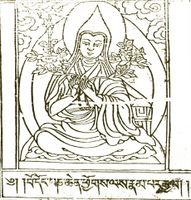Bodong Paṇchen Chokle Namgyal
| PersonType | Category:Classical Tibetan Authors |
|---|---|
| MainNamePhon | Bodong Paṇchen Chokle Namgyal |
| MainNameTib | བོ་དོང་པཎ་ཆེན་ཕྱོགས་ལས་རྣམ་རྒྱལ་ |
| MainNameWylie | bo dong paN chen phyogs las rnam rgyal |
| SortName | Bodong Paṇchen Chokle Namgyal |
| AltNamesTib | འཇིགས་མེད་གྲགས་པ་ · གཡུང་དྲུང་སངས་རྒྱས་སྐྱིད་ · གཞུང་ལུགས་འབུམ་ཕྲག་བརྒྱ་པ་ · འབུམ་ཕྲག་བརྒྱ་པ་ · ཆོས་ཀྱི་རྒྱལ་མཚན་ · གསང་བ་བྱིན་ · དབྱངས་ཅན་དགའ་བ་ |
| AltNamesWylie | 'jigs med grags pa · g.yung drung sangs rgyas skyid · gzhung lugs 'bum phrag brgya pa · 'bum phrag brgya pa · chos kyi rgyal mtshan · gsang ba byin · dbyangs can dga' ba |
| bio | (Chokle Namgyal) (1376-1451). The twenty-third abbot of Bo dong E monastery, founded in about 1049 by the Bka' gdams geshe (dge bshes) Mu dra pa chen po, and the founder of the Bo dong tradition. His collected works, said to number thirty-six titles, include his huge encyclopedic work De nyid 'dus pa ("Compendium of the Principles"); it alone runs to 137 volumes in the incomplete edition published by the Tibet House in Delhi. Phyogs las rnam rgyal (who is sometimes confused with Jo nang pa Phyogs las rnam rgyal who lived some fifty years earlier) was a teacher of Dge 'dun grub (retroactively named the first Dalai Lama) and Mkhas grub Dge legs dpal bzang, both students of Tsong kha pa. Among his disciples was the king of Gung thang, Lha dbang rgyal mtshan (1404–1463), whose daughter Chos kyi sgron me (1422–1455) became a nun after the death of her daughter and then the head of Bsam lding (Samding) monastery, which her father founded for her. The monastery is the only Tibetan monastery whose abbot is traditionally a woman; incarnations are said to be those of the goddess Vajravārāhī (T. Rdo rje phag mo), "Sow-Headed Goddess." (Source: "Bo dong Phyogs las rnam rgyal." In The Princeton Dictionary of Buddhism, 139. Princeton University Press, 2014. http://www.jstor.org/stable/j.ctt46n41q.27.) |
| YearBirth | 1376 |
| YearDeath | 1451 |
| TibDateGender | Male |
| TibDateElement | Fire |
| TibDateAnimal | Dragon |
| TibDateRabjung | 6 |
| BDRC | https://www.tbrc.org/#!rid=P2627 |
| IsInGyatsa | No |
| BnwShortPersonBio | (Chokle Namgyal) (1376-1451). The twenty-third abbot of Bo dong E monastery, founded in about 1049 by the Bka' gdams geshe (dge bshes) Mu dra pa chen po, and the founder of the Bo dong tradition. His collected works, said to number thirty-six titles, include his huge encyclopedic work De nyid 'dus pa ("Compendium of the Principles"); it alone runs to 137 volumes in the incomplete edition published by the Tibet House in Delhi. Phyogs las rnam rgyal (who is sometimes confused with Jo nang pa Phyogs las rnam rgyal who lived some fifty years earlier) was a teacher of Dge 'dun grub (retroactively named the first Dalai Lama) and Mkhas grub Dge legs dpal bzang, both students of Tsong kha pa. Among his disciples was the king of Gung thang, Lha dbang rgyal mtshan (1404–1463), whose daughter Chos kyi sgron me (1422–1455) became a nun after the death of her daughter and then the head of Bsam lding (Samding) monastery, which her father founded for her. The monastery is the only Tibetan monastery whose abbot is traditionally a woman; incarnations are said to be those of the goddess Vajravārāhī (T. Rdo rje phag mo), "Sow-Headed Goddess." (Source: "Bo dong Phyogs las rnam rgyal." In The Princeton Dictionary of Buddhism, 139. Princeton University Press, 2014. http://www.jstor.org/stable/j.ctt46n41q.27.) |
| Other wikis |
If the page does not yet exist on the remote wiki, you can paste the tag |


